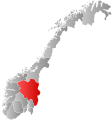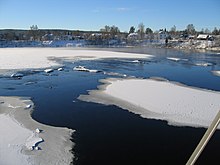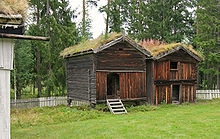Elverum
Elverum kommune | |
|---|---|
 Elverum in August 2006 | |
 Coat of arms  Innlandet within Norway | |
 Elverum within Innlandet | |
| Coordinates: 60°55′39″N 11°42′55″E / 60.92750°N 11.71528°ECoordinates: 60°55′39″N 11°42′55″E / 60.92750°N 11.71528°E | |
| Country | Norway |
| County | Innlandet |
| District | Østerdalen |
| Administrative centre | Elverum |
| Government | |
| • Mayor (2019) | Lillian Skjærvik[1] (Ap) |
| Area | |
| • Total | 1,229 km2 (475 sq mi) |
| • Land | 1,209 km2 (467 sq mi) |
| Area rank | 80 in Norway |
| Population (01.01.2018) | |
| • Total | 21,211 |
| • Rank | 54 in Norway |
| • Density | 17.5/km2 (45/sq mi) |
| • Change (10 years) | |
| Demonym(s) | Elverumsing Elverumsokning[2] |
| Time zone | UTC+01:00 (CET) |
| • Summer (DST) | UTC+02:00 (CEST) |
| ISO 3166 code | NO-3420 |
| Official language form | Neutral[3] |
| Website | www |
Elverum (![]() Norwegian pronunciation) is a city and municipality in Innlandet county, Norway. It is part of the traditional region of Østerdalen. The administrative centre of the municipality is the town of Elverum. The municipality of Elverum was established on 1 January 1838 (see formannskapsdistrikt).
Elverum lies at an important crossroads, with Hamar to the west, Kongsvinger to the south, and Trysil on the Swedish border to the northeast. It is bordered on the north by Åmot municipality, in the northeast by Trysil municipality, in the southeast by Våler, and in the west by Løten.[4]
Norwegian pronunciation) is a city and municipality in Innlandet county, Norway. It is part of the traditional region of Østerdalen. The administrative centre of the municipality is the town of Elverum. The municipality of Elverum was established on 1 January 1838 (see formannskapsdistrikt).
Elverum lies at an important crossroads, with Hamar to the west, Kongsvinger to the south, and Trysil on the Swedish border to the northeast. It is bordered on the north by Åmot municipality, in the northeast by Trysil municipality, in the southeast by Våler, and in the west by Løten.[4]
General information[]
The name[]
The municipality (originally the parish) is named after the old Elverum farm (Old Norse: Alfarheim), since the first church was built here. The first element is the genitive case of elfr which means "river" (here the Glomma river) and the last element is heim which means "home/homestead" or "farm".
Coat-of-arms[]
The coat-of-arms is from modern times. They were granted on 9 December 1988. The arms show a gold-colored owl on a red field. This was chosen as a symbol for wisdom since there are many schools in the municipality. The owl also seems somewhat aggressive, to represent the fighting spirit of Norwegians. In 1940, when Norway was under attack from the German forces, King Haakon VII received the power from the parliament to govern the country, in its best interests while he was in Elverum.[5][6]
Sagtjernet[]

Sagtjernet is a lake in the Northern parts of Elverum, it is a main place for residents to visit in the summer. It is a lake formed by the last ice age.
| Ancestry | Number |
|---|---|
| 283 | |
| 238 | |
| 112 | |
| 109 | |
| 102 | |
| 99 | |
| 98 | |
| 90 | |
| 79 | |
| 63 | |
| 56 | |
| 55 | |
| 52 | |
| 51 |
History[]
Military ties[]
During the Nordic Seven Years' War (1563–1570), Swedish troops invaded Norway in a number of locations, including a number of incursions into Østerdalen. In 1563, Norwegian troops stopped the Swedish advance at Elverum, which provided a strategic point since it lay on both north-south and east-west trade and travel routes.
The parishes of Idre and Särna originally belonged to Elverum. But they were occupied by Swedish troops in 1644, and since then lost to Sweden.
Construction of fortifications started in 1673 during the Gyldenløve War as Hammersberg Skanse. It was renamed Christiansfjeld Fortress in 1685 by King Christian V of Denmark during his visit to Hammersberg Skanse on June 14. Although the fortress was manned through the Great Northern War, the city was spared major battles. In 1742, Christiansfjeld Fortress was closed.
A Norwegian infantry regiment, the Oppland Regiment, was formed in 1657 and Elverum became a garrison town. The area of population east of the river called Leiret (literally the camp) adjacent to Christiansfjeld Fortress was built up by soldiers as well as the merchants and craftsmen who settled nearby. Even to this day the area of Elverum central areas east of the river is referred to as Leiret.
In 1878, Terningmoen at Elverum became the home base for the Oppland Regiment and an infantry school was founded here in 1896.
The Oppland Regiment had a history which included courageous involvement in combat from the Swedish wars of the 17th century through the German invasion of Norway in 1940. As part of the general restructuring, the unit was disbanded in 2002.
Today, Terningmoen hosts several sub units within the Norwegian army and the Home guard.
Regional town[]
In the Danish-Norwegian period, Elverum was the location for a bailiff (fogd), a judge (sorenskriver), a head pastor (prost), and numerous military officers.
It became important as a market town as well. In 1570 Hamar Cathedral in Hamar was burned and Hamarhus castle was destroyed by the Swedish armies during the Seven Years' War with Sweden. Hamar lost its city status, leaving no kjøpstad, or official market city, between Christiania and Trondheim. Eastern Norway needed an organized market for trading goods. The Grundset market (Grundsetmart'n) in Elverum municipality grew to meet the need. It is recorded as existing in the 17th century, and in 1765 the owner of Gaarder obtained special market privileges from the king, to take place six miles north of the population center of Elverum on his estate. By 1767, it was described as Norway's largest and most famous market. In the first week of March, for almost 300 years, the folks of the district met to trade and to celebrate. People from Gudbrandsdal, Oslo, Trøndelag, and Sweden also regularly came to Grundsetmart'n. The Grundset market was finally abandoned in 1901, when pressures of the railroad and other markets made it superfluous.

The railway connecting Oslo and Trondheim passed through Elverum in 1877.
World War II[]
Elverum municipality served as a temporary capital of Norway during the World War II German invasion. On 9 April 1940 Norwegian troops prevented German parachute troops from capturing Norway's King Haakon, Crown Prince, and Parliament while the Parliament was meeting to issue the Elverum Authorization, authorizing the exiled government until the Parliament could again convene. On April 11, shortly after the government's refusal to submit to German terms, the center of Elverum was reduced to ashes.
Museums[]
Norwegian Forest Museum[]

The Norwegian Forest Museum is a national museum recognizing the importance of forestry, hunting, and fishing to the Norwegian history and economy.
Glomdal Museum[]
From the eastern side of Glomma (the Museum of Norwegian Forestry – Skogmuseet), a pedestrian bridge across the Klokkerfoss waterfall to Prestøya, and then a bridge across the Prestfossen falls leads to the Glomdal Museum, one of the largest Norwegian outdoor museums, with numerous houses from the mountain parishes of Østerdalen and the lowland districts of Solør on the Glomma river valley. The exhibition includes a library with numerous books, including handwritten medieval manuscripts.

Elverum Church[]
Elverum church (Elverum kirke) is a cruciform church. Access to the site is via Fylkesvei 553 and Riksvei 2/ Riksvei 25. The church was built in 1736 and inaugurated in 1738. The edifice is of wood and has 700 seats. The church was greatly changed in 1878 under the leadership of architect Henrik Thrap-Meyer. In 1937–38, the interior from the 1700s was restored with the windows and entrance doors returned to the original shape. The decorative leaf decor in the chancel was completed and galleries reconstructed.[8]
Notable residents[]
Public service & public thinking[]

- Kristoffer Nilsen Svartbækken Grindalen (1804 in Elverum – 1876) a criminal, killer and thief
- Stener Johannes Stenersen (1835 in Elverum – 1904) a veterinarian, author of first monograph on the Fjord horse
- Hartvig Andreas Munthe (1845 in Elverum – 1905) a military officer, engineer and genealogist
- Carl Oscar Munthe (1861 in Elverum – 1952) a Norwegian military officer and historian
- Olav Jørgen Sæter (1884 in Elverum – 1951) a schoolteacher, newspaper editor and politician; Mayor of Elverum 1931 to 1940
- Kristian Løken (1884 in Elverum – 1961) a highly decorated Norwegian military officer
- Knut Storberget (born 1964 in Elverum) lawyer and politician, Governor of Innlandet from 2019
- Bjørn Jarle Rødberg Larsen (born 1973) a Norwegian internet entrepreneur and politician
The Arts[]


- Gerhard Munthe (1849 in Elverum – 1929) a Norwegian painter and illustrator
- Margrethe Munthe (1860 in Elverum – 1931) a children's writer, songwriter and playwright
- Marie Hamsun (1881 in Elverum – 1969) an actress and writer; wife of Knut Hamsun[9]
- Åsmund Sveen (1910 in Elverum – 1963) a poet, novelist and literary critic; purged after WWII
- Gunnar Sønstevold (1912 in Elverum – 1991) a Norwegian composer of orchestral works, vocal music, chamber music, and music to a number of plays, ballets and films [10]
- Dagfinn Grønoset (1920–2008) a journalist and writer, lived in Elverum
- Bjørn Ole Rasch (born 1959 in Elverum) a keyboard player, composer and producer
- Baard Slagsvold (born 1963 in Elverum) a Norwegian pop and jazz musician
- Brita Cappelen Møystad, (Norwegian Wiki) (born 1966 in Elverum) film reviewer and journalist
- Tord Øverland-Knudsen, bass player in The Wombats an English indie rock band formed in Liverpool in 2003
- Rawdna Carita Eira (born 1970 in Elverum) a Norwegian and Sámi playwright and author
- Roy Khan (born 1970 in Elverum) a Norwegian singer-songwriter, former lead singer of Kamelot
- Camilla Granlien (born 1974 in Elverum) a Norwegian folk singer, stev performer and educator
- Sigurd Hole (born 1981 in Elverum) a Norwegian jazz musician, plays upright bass
- Marcus & Martinus (born 2002 in Elverum) twins brothers Marcus and Martinus Gunnarsen, a Norwegian pop-duo
Sport[]

- Ole Østmo (1866 in Elverum – 1923) a sharpshooting champion, won four medals at the 1900 Summer Olympics
- Hans Anton Aalien (born 1958 in Elverum) a blind gold medalist in the disabled skiing at the 1988 Winter Olympics
- Bjørn Dæhlie(born 1967 in Elverum) a retired Norwegian cross-country skier with 8 gold and 4 silver Winter Olympic medals
- Anita Moen (born 1967) a Norwegian former cross-country skier, won three silver and two bronze medals at the Winter Olympics
- Stig Inge Bjørnebye (born 1969 in Elverum) a former footballer with 317 club caps and 76 for Norway
- Rune Djurhuus (born 1970 in Elverum) a chess player, Norwegian International Grandmaster
- Gyda Ellefsplass Olssen (born 1978 in Elverum) a sport shooter, competed at the 2008 Summer Olympics
- Håvard Storbæk (born 1986 in Elverum) a former footballer with over 320 club caps
- Vegar Eggen Hedenstad (born 1991 in Elverum) a footballer with over 250 club caps
Twin towns – sister cities[]
Elverum is twinned with:[11]
 Haslev, Denmark
Haslev, Denmark Siilinjärvi, Finland
Siilinjärvi, Finland Sunne, Sweden
Sunne, Sweden Tsumeb, Namibia
Tsumeb, Namibia
See also[]
References[]
- ^ "(+) Ordførerskifte i Elverum: – Det blir harde tak, men gleden overgår det vanskelige". www.ostlendingen.no (in Norwegian). 2019-10-16. Retrieved 2019-10-18.
- ^ "Navn på steder og personer: Innbyggjarnamn" (in Norwegian). Språkrådet.
- ^ "Forskrift om målvedtak i kommunar og fylkeskommunar" (in Norwegian). Lovdata.no.
- ^ Morten Haugen. "Elverum". Store norske leksikon. Retrieved October 1, 2016.
- ^ Norske Kommunevåpen (1990). "Nye kommunevåbener i Norden". Retrieved 2008-12-21.
- ^ "Kommunevåpnet" (in Norwegian). Elverum kommune. Archived from the original on 2011-07-24. Retrieved 2008-12-21.
- ^ "Immigrants and Norwegian-born to immigrant parents, by immigration category, country background and percentages of the population". ssb.no. Archived from the original on 2 July 2015. Retrieved 26 June 2017.
- ^ "Elverum Kirke". Den norske kirke. Retrieved October 1, 2016.
- ^ IMDb Database retrieved 22 October 2020
- ^ IMDb Database retrieved 22 October 2020
- ^ "Vennskapsbyer" (in Norwegian). Elverum kommune. Archived from the original on 2011-07-24. Retrieved 2008-12-21.
External links[]
![]() Media related to Elverum at Wikimedia Commons
Media related to Elverum at Wikimedia Commons
![]() The dictionary definition of Elverum at Wiktionary
The dictionary definition of Elverum at Wiktionary
- Municipal fact sheet from Statistics Norway
- Municipal website (in Norwegian)
- Elverum
- Municipalities of Hedmark
- Cities and towns in Norway
- Populated places in Hedmark
- Populated places on the Glomma River


